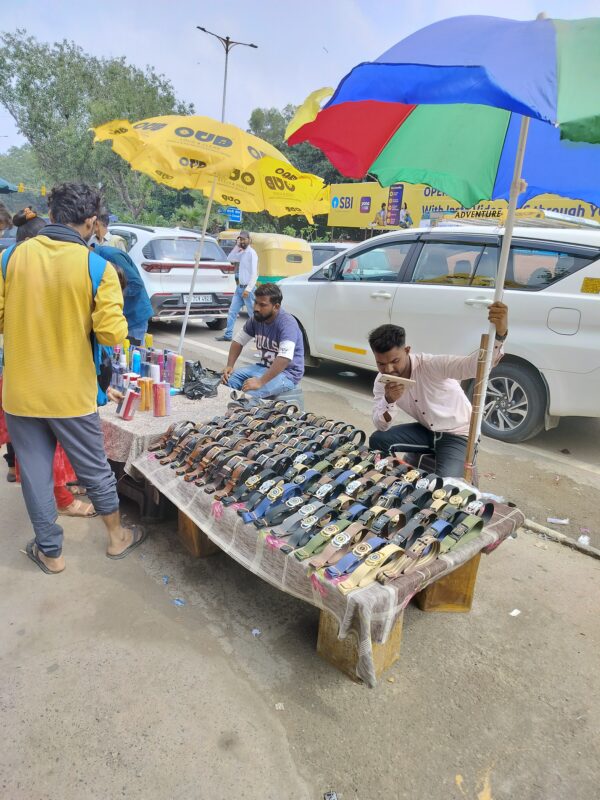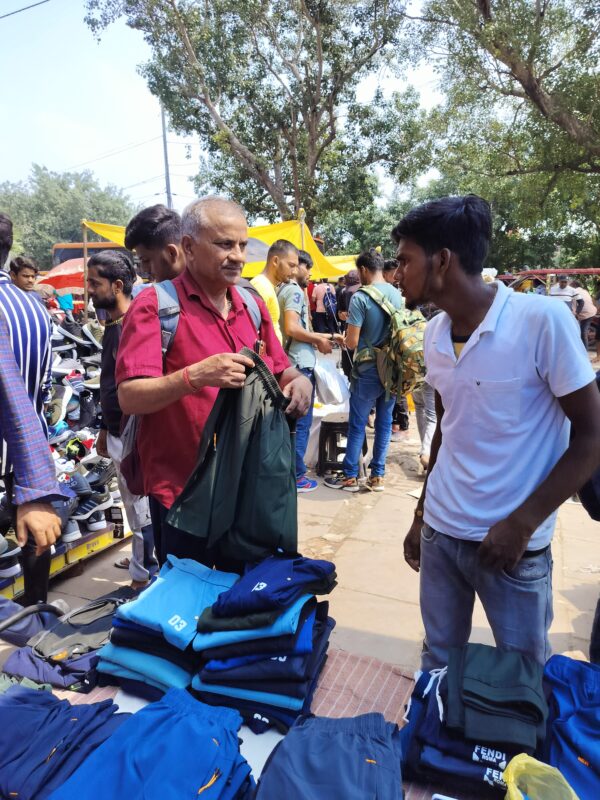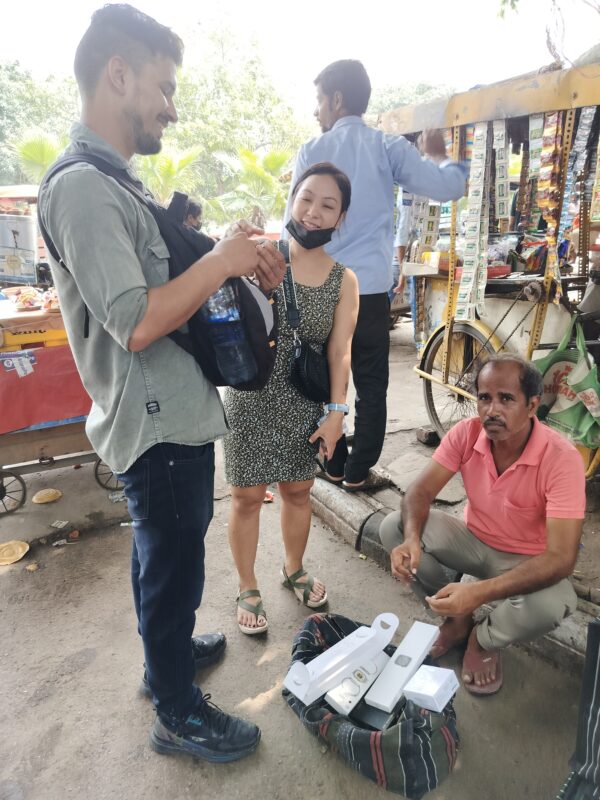With a wide, joyous grin, 26-year-old Mohit Yadav revels in the satisfaction of securing a remarkable deal.
His triumphant acquisition consists of an Apple watch at a mere 500 rupees, much lower than the shopkeeper’s initial demand of 3,500 rupees.
In the midst of cacophony of voices reverberating within medieval-era walls, where old world meets the new, Chor Bazaar comes to life, emerging like a rebirth of a forgotten era.
Each small item has its own tale to share in this place, every old object holds a shred of nostalgia, and every artifact conceals the mysteries of bygone lives.
Yadav says, “I am a frequent visitor to Chor Bazaar, drawn by the possibility of remarkable bargains. I already had an Apple watch which I had bought for Rs 1,000. While strolling through the market, I met a salesman who had a similar timepiece on display, priced at Rs 3,500. I know that neither of these is an authentic Apple watch, which commands a significantly higher price. However, my desire to acquire a new one led me to engage with the vendor with an offer of 500 rupees.”
This weekly market, which draws large crowds searching for affordable second-hand items, is currently located near Subhash Park close to the Red Fort.
The market has changed many addresses over the years – from the charming Sanjay Van Talab to the bustling Chawri Bazaar, with the majestic Red Fort as its backdrop and the historic ambiance of Jama Masjid. It later found home in the serene embrace of Subhash Park, once known as Edward Park, and the prestigious Kasturba Hospital, formerly Victoria Hospital. Despite shifting places, it continues to have a high number of vendors – 300 in number.
HISTORICAL OVERVIEW
Also known as Kabaadi Bazar, the Chor Bazaar has a captivating history that weaves through centuries of Delhi’s existence.
Its origins trace back to the 17th century when Shahjahanabad, the capital of Mughal empire, was born.
Chor Bazaar then served as a clandestine haven for stolen wares, shrouded in whispers of clandestine deals.
Through the tumultuous era of British colonial rule, Chor Bazaar retained its allure. It was a place where one could acquire almost anything, often at astonishingly reasonable prices. Stories of treasures and curiosities found in its labyrinthine alleys became legendary.
The winds of change swept through Chor Bazaar after India’s independence in 1947. Vigorous efforts were undertaken to cleanse the market of its shady past.

Gradually, the market metamorphosed into a haven for aficionados of antique items and collectors of vintage gems. It became a place where history came alive through antique furniture, vintage clothing, old books, and an eclectic array of collectibles.
Noteworthy among its offerings is the renowned Sunday Book Market in Daryaganj, which is often considered an integral part of Chor Bazaar. This weekly market lures bibliophiles from every corner of Delhi, with its extensive collection of both new and cherished used books, all at accessible prices.
Sohail Hashmi, a writer-filmmaker with a deep passion for history and heritage, who has dedicated over sixteen years to leading heritage walks in Delhi, says, “The evolution of Chor Bazaar over the years is a testament to city’s ever-changing pulse. Today, it stands as a delightful blend of the old and the new, where tradition and modernity co-exist harmoniously. It is not just a shopping destination; it’s a journey through time and a sensory immersion into the vibrant tapestry of old Delhi. The transformation from a den of illicit goods to a treasury of antiquities and vintage marvels mirrors the city’s resilience and the enduring spirit of its bustling markets.”
He says, “As you step into Daryaganj, to the left, a captivating book market unfurls along the pavement. Its enchanting stalls stretch almost all the way to Sir Syed Road, meandering gracefully past Golcha and culminating at the venerable MCD library. Originally, this literary haven was adorned with rows of second-hand books, each with its own unique story. Over time, this bibliophile’s paradise transformed, metamorphosing into a bustling emporium of posters, their vibrant colours enticing passersby.”
In those bygone days, electronics had yet to claim dominance, leaving room for simpler pleasures like hand-wound record players — their arms delicately tracing the grooves of 78 RPM and 33 RPM records. Each record was a time capsule, holding a solitary song or a carefully composed masterpiece, a symphony that lasted about three mesmerising minutes.
VENDORS’ PROBLEMS
Despite its rich history, there are multiple problems as shopkeepers confront unique and complex challenges that shape their daily operations and livelihoods.
One of the foremost problems they have to contend with is market’s reputation as a place selling potentially stolen or illicit goods. It means that shopkeepers often face the threat of raids and prosecution, which cast a shadow over their businesses.
Security is a primary concern, given the market’s informal nature. It attracts petty thefts and causes problems like pick-pocketing for both visitors and vendors. To safeguard their shops and merchandise, they are compelled to make substantial investments in security measures.
Besides, the sellers often find it challenging to establish trust with customers and legitimate suppliers, adding another layer of difficulty to their trade.
“Intense competition within the market further compounds their struggles, making it hard to earn a decent profit. Moreover, the unpredictable nature of the inventory, consisting of second-hand or dubiously sourced items, poses a constant challenge. Shopkeepers find it hard to plan their businesses when they cannot rely on a consistent flow of stock,” explains Akhtar Khan, a professor of economics in University of Delhi.
Frequent police inspections and inquiries amplify the stress faced by shopkeepers. These encounters only serve to exacerbate their already precarious situations.
Muzamil , a 23-year-old entrepreneur, finds himself in a challenging situation. Recently, he faced obstacles when trying to set up his second-hand perfumery cart, featuring brands like Set Wet and Archies.
Notably, he was discouraged from operating his shop during the G20 event, and prior to that, the Independence Day celebration also meant that he couldn’t conduct his business as usual.
In the face of these recurring setbacks, Muzamil’s concern is a reflection of the broader struggle that many small business owners endure.

He says, “I fail to understand why many believe that we engage in illegal or unethical activities here. In reality, people in this place are skilled negotiators who are thoroughly informed and aim to secure the most advantageous deals for themselves.
Nonetheless, the profit margins on second-hand products are quite minimal. Some individuals even request items for as little as 20 rupees.”
The looming threat of relocation casts an uncertain shadow over the future of their businesses.
Urban development projects uproot them and potentially force them to start anew, adding to the already daunting challenges they face.
NEED FOR A STRONG INFRASTRUCTURE
Chor Bazar has historically faced several infrastructure and hygiene issues. Firstly, congestion plagues the market, making navigation difficult and hindering waste disposal efforts, which contributes to uncleanliness.
Inadequate sanitation facilities and a lack of public toilets further lead to unclean surroundings. The roads to Chor Bazaar often have potholes and uneven surfaces, posing safety concerns.
The informal setup of the market further complicates matters related to cleanliness and organisation, as vendors set up shop on the streets.
Raghuveer, a 40-year-old, who has seen the market for over a decade, says, “Over time, our customer base has dwindled due to the excessive clutter in the alleys and the absence of parking spaces. Hygiene is another concern. There are no mobile toilets as such and if the weather is unfavourable, we have to think whether to set up our shops or not.”
The vendors have temporary structures here as they migrate from one market to another. Some simply sit on the pavement to sell items that they mostly buy from wholesale markets like Gandhinagar.

Many vendors come from cities in Uttar Pradesh and Haryana.
“I have this folding wooden table which I use for displaying items. The competition among the vendors here is stiff as customers move from one vendor to another quickly and I have to sell my goods at a very low price and minimal profit,” shares Neena Kumari, 43. The vendors have to keep up with the changing times too. Online transactions have affected the people in the market.
“I don’t even have a smartphone, then how will I deal with customers. People these days simply ask for a scanner to quickly transfer money. But for people like us who aren’t tech avvy, how would we earn our livelihoods? People just go to another vendor who has a Paytm mode of payment and buy from him. This is affecting my work,” says Shanti, 53, a vendor. In sum, the vendors in Chor Bazaar have multiple challenges. But they look for hope and development in the coming years.





